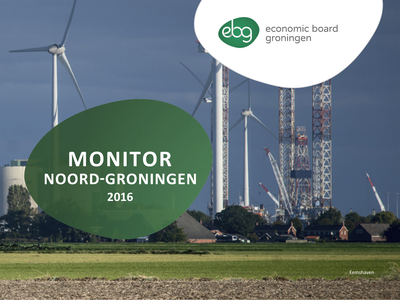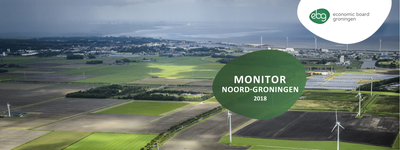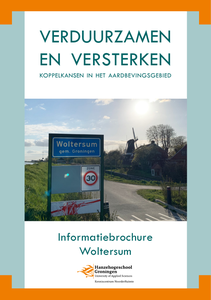Hoe staan de negen gemeenten in het hart van het aardbevingsgebied in Noord-Groningen er voor? De Economic Board Groningen (EBG) liet economen van Hanzehogeschool Groningen en de Rijksuniversiteit Groningen er onderzoek naar doen.De Economic Board Groningen wil weten welke effecten het programma van EBG heeft op de economie van de negen gemeenten in het aardbevingsgebied. Om dat te kunnen vaststellen hebben economen van de Rijksuniversiteit Groningen en de Hanzehogeschool Groningen in opdracht van de Economic Board de huidige situatie in de negen Noord-Groninger gemeenten gemeten.
DOCUMENT

Hoe staan de negen gemeenten in het hart van het aardbevingsgebied in Noord-Groningen er voor? De Economic Board Groningen (EBG) liet economen van Hanzehogeschool Groningen en de Rijksuniversiteit Groningen er onderzoek naar doen.De Economic Board Groningen wil weten welke effecten het programma van EBG heeft op de economie van de negen gemeenten in het aardbevingsgebied. Om dat te kunnen vaststellen is een Monitor ontwikkeld van met name een aantal economische variabelen, zoals de werkgelegenheid. Deze monitor is een vervolg op die uit 2016.
DOCUMENT

I was somewhat surprized with the fog in Groningen upon my arrival. This is notthe fog that covers the beautiful landscapes of the northern Netherlands in theevening and in the early morning. No… It is the fog that obscures the real aspectsof the earthquake problem in the region and is crystallised in the phrase “Groningen earthquakes are different”, which I have encountered numerous times whenever I raised a question of the type “But why..?”. A sentence taken out of the quiver as the absolute technical argument which mysteriously overshadows the whole earthquake discussion.Q: Why do we not use Eurocode 8 for seismic design, instead of NPR?A: Because the Groningen earthquakes are different!Q: Why do we not monitor our structures like the rest of the world does?A: Because the Groningen earthquakes are different!Q: Why does NPR, the Dutch seismic guidelines, dictate some unusual rules?A: Because the Groningen earthquakes are different!Q: Why are the hazard levels incredibly high, even higher than most Europeanseismic countries?A: Because the Groningen earthquakes are different!and so it keeps going…This statement is very common, but on the contrary, I have not seen a single piece of research that proves it or even discusses it. In essence, it would be a difficult task to prove that the Groningen earthquakes are different. In any case it barricades a healthy technical discussion because most of the times the arguments converge to one single statement, independent of the content of the discussion. This is the reason why our first research activities were dedicated to study if the Groningen earthquakes are really different. Up until today, we have not found any major differences between the Groningen induced seismicity events and natural seismic events with similar conditions (magnitude, distance, depth, soil etc…) that would affect the structures significantly in a different way.Since my arrival in Groningen, I have been amazed to learn how differently theearthquake issue has been treated in this part of the world. There will always bedifferences among different cultures, that is understandable. I have been exposed to several earthquake engineers from different countries, and I can expect a natural variation in opinions, approaches and definitions. But the feeling in Groningen is different. I soon realized that, due to several factors, a parallel path, which I call “an augmented reality” below, was created. What I mean by an augmented reality is a view of the real-world, whose elements are augmented and modified. In our example, I refer to the engineering concepts used for solving the earthquake problem, but in an augmented and modified way. This augmented reality is covered in the fog I described above. The whole thing is made so complicated that one is often tempted to rewind the tape to the hot August days of 2012, right after the Huizinge Earthquake, and replay it to today but this time by making the correct steps. We would wake up to a different Groningen today. I was instructed to keep the text as well as the inauguration speech as simple aspossible, and preferably, as non-technical as it goes. I thus listed the most common myths and fallacies I have faced since I arrived in Groningen. In this book and in the presentation, I may seem to take a critical view. This is because I try to tell a different part of the story, without repeating things that have already been said several times before. I think this is the very reason why my research group would like to make an effort in helping to solve the problem by providing different views. This book is one of such efforts.The quote given at the beginning of this book reads “How quick are we to learn: that is, to imitate what others have done or thought before. And how slow are we to understand: that is, to see the deeper connections.” is from Frits Zernike, the Nobel winning professor from the University of Groningen, who gave his name to the campus I work at. Applying this quotation to our problem would mean that we should learn from the seismic countries by imitating them, by using the existing state-of-the-art earthquake engineering knowledge, and by forgetting the dogma of “the Groningen earthquakes are different” at least for a while. We should then pass to the next level of looking deeperinto the Groningen earthquake problem for a better understanding, and alsodiscover the potential differences.
DOCUMENT

ABSTRACT: Local homebuyers in the Groningen earthquake regionIr. Hieke T. van der KloetHanze University of Applied Sciences GroningenResearch Centre for Built Environment NoorderRuimteh.t.van.der.kloet@pl.hanze.nl0031-50-595-2015The earthquakes after the natural gas extraction in the Groningen region of the Netherlands have a significant impact on the housing market and sustainability of the communities in this region. Since the strongest earthquake around the community of Huizinge in August 2012, with an magnitude of 3.6 on the Richter scale, it became clear there is a relation between natural gas extraction and earthquakes due to soil subsidence. As a consequence houses in the region get damaged and after research it gets obvious housing prices decline and the region will become unattractive to potential buyers of houses, damaged or not. Therefore the Dutch Petroleum Company (NAM) since April 29th 2014 offers a compensation for the loss of the housing price before and after the earthquake of Huizinge to property owners who want to sell their home. They only get the compensation after a sales deal and only if they agree with the proposed compensation. Since the compensation for the decrease in house prices has been introduced, the number of participants of the regulation is lacking behind the actual sales of houses. Our study aims to contribute to the research on the consequences of earthquakes by natural gas mining on the real estate market in the northern part of the Netherlands, especially the Groningen region. First of all we want to declare why relatively a large part of the property owners (about 60% until 2015) don’t request for the compensation regulation. Our second question concerns the buyers of the (damaged) houses in the earthquake area. Why would they buy a home in a region full of risks? Who are these buyers? We use a mixed-method approach for data collection which leads to an analysis of a unique dataset on notarial deeds of house sales in nine municipalities in the Groningen earthquake region according to The Land Registry of the Netherlands during the period 2013 until the end of 2015 as well as discovering common patterns of interview results with residents and experts. First results show that the majority of the homebuyers originate from the local earthquake area in the Province of Groningen. Reasons why property sellers after the house sale don’t opt for the compensation regulation concerns the complexity of the regulation, the used valuation model and the expected long control time afterwards.From the first results we conclude that the Groningen earthquake region still has its attractiveness for local residents and buyers. Otherwise the regulation for compensation doesn’t reach enough property sellers in the nine municipalities of the Groningen earthquake region. Advise to the Dutch government should be to generously compensate the residents of the Groningen earthquake regions for the loss of value of their dwellings, damaged or not. This will help to improve the regional development and attractiveness of areas that are effected by earthquakes.
DOCUMENT
The earthquakes after the natural gas extraction in the Groningen region of the Netherlands have a significant impact on the housing market and sustainability of the communities. Since the strongest earthquake around the community of Huizinge in August 2012, with a magnitude of 3.6 on the Richter scale, it became clear there is a relation between natural gas extraction and earthquakes due to soil subsidence. As a consequence houses in the region get damaged and after research it is obvious that housing prices decline and the region might become unattractive to potential buyers of houses. Therefore the Dutch Petroleum Company (NAM) since April 29th 2014 offers a compensation for the loss of the housing price to property owners who want to sell their home. Since the compensation has been introduced, the number of participants of the regulation is lacking behind the actual sales of houses. Our study aims to contribute to the research on the consequences of earthquakes by natural gas mining on the real estate market in the Groningen region. First of all we want to declare why relatively a large part of the property owners (about 60% until 2015) don’t request for the compensation regulation. Our second question concerns the buyers of the (damaged) houses in the earthquake area. Who are these buyers? Why would they buy a home in a region full of risks? We use a mixed-method approach for data collection which leads to an analysis of a unique dataset on notarial deeds of house sales in nine municipalities in the Groningen earthquake region according to The Land Registry of the Netherlands during the period 2013 until 2015 as well as discovering common patterns of interview results with residents and experts.First results show the majority of the homebuyers originate from the local earthquake area in the Province of Groningen. Reasons why property sellers after the house sale don’t opt for the compensation regulation concerns the complexity of the regulation, the used valuation model and the expected long control time afterwards.We conclude the Groningen earthquake region still has it’s attractiveness for local residents and buyers. Otherwise the regulation for compensation doesn’t reach enough property sellers in the Groningen earthquake region. Advise to the Dutch government should be to generously compensate the residents of the Groningen earthquake regions for the loss of the value of their dwellings, damaged or not. This will help to improve the regional development and attractiveness of areas that are effected by earthquakes.
DOCUMENT
De provincie Groningen heeft HanzePro gevraagd om een verkenning te doen naar de stand van zaken binnen de restauratiebranche in Groningen, met aandacht voor onderwijs, arbeidsmarkt en innovaties. Het doel van de verkenning is om te komen tot een realistisch en gezamenlijk beeld van de huidige situatie en wat vervolgens nodig is om de restauratiebranche in de provincie Groningen toekomstbestendig te maken. In het voorliggende rapport is de verkenning en haar uitkomsten beschreven.
DOCUMENT

In het project Koppelkansen hebben inwoners van Appingedam, Kantens,Stitswerd en Loppersum meegedacht over hoe de versterkingsoperatiekan worden benut voor de verduurzaming van de huizen. Het projectwerd geleid door twee onderzoekers van het Kenniscentrum Noorder-Ruimte (Hanzehogeschool Groningen), in samenwerking met drie lokaleenergiecoöperaties: LOPEC uit Loppersum, Eendracht uit Appingedam enE.I.K. uit Kantens. Dit boekje biedt inspiratie en praktische tips voor bewoners om zelf verder aan de slag te gaan met de verduurzaming van hun woningen.
DOCUMENT

In opdracht van Economic Board Groningen heeft Marklinq, na 2016 en 2018, een derde Monitor van de Economie van Noord-Groningen opgesteld. Een van de conclusies: de werkgelegenheid is in de periode 2015-2019 licht gestegen in de regio, ondanks aardbevingen en veronderstelde leegloop.
DOCUMENT

De afgelopen jaren heeft het aardbevingsgebied te maken gehad met veel ontwikkelingen. Momenteel staat deze regio voor grote opgaven rondom zowel het versterken en verduurzamen van woningen. Er liggen mogelijkheden om beide opgaven tegelijk aan te pakken, ook wel ‘koppelkansen’ genoemd. Dit onderzoek richt zich op het inzichtelijk maken van de koppelkansen in verschillende Groningse dorpen, waaronder Woltersum. Daarnaast kijkt het naar de bereidheid en mogelijkheden van haar bewoners om die koppelkansen (al dan niet gezamenlijk) op te pakken en de rol die de lokale energiegroepen daarin kunnen spelen. Met die inzichten willen we de Groninger dorpen op weg helpen in het voorbereiden en inrichten van de versterkings- en verduurzamingsopgave. Deze rapportage richt zich op het dorp Woltersum, waar we in november en december 2020 onderzoek hebben gedaan. Dit in samenwerking met de Woltersumse Energie Coöperatie.
DOCUMENT
